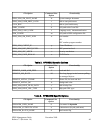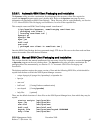Note that having encryption types other than "des-cbc-crc" first on the "default_tkt_enctypes" and
"default_tgs_enctypes" lines can cause authentication failures. Specifically, keytab files generated by the
HPSS utility programs will use the first encryption type and only "des-cbc-crc" is known to work in all
cases. Other encryption types are known to fail for some OSs and Java implementations. Also, when kinit
is used with a keytab file, it only checks the first encryption type listed on the default lines in krb5.conf.
If the keytab was generated with a different encryption type, the authentication will fail.
3.3.4. SSM Help Files (Optional)
The SSM Help Files are an HTML version of the HPSS Management Guide. Individual sections of this
guide are available from the Help menus on the SSM windows.
To access help windows from the hpssgui, the Help Files must be accessible from each client machine.
We recommend storing these files in a file system shared by the clients so that they don't need to be
installed on every SSM client machine. By default, the hpssgui script looks for the help files in
$HPSS_HELP_FILES_PATH. The default location is /var/hpss/doc and can be overridden by using the -
f option.
Help files are distributed with HPSS or can be downloaded from the HPSS web site. They should be
installed in the $HPSS_HELP_FILES_PATH location and/or the path specified by the -f option. Refer to
the HPSS Installation Guide, Section 5.5 HPSS Documentation & Manual Page Setup for instructions on
how to install the help files. See the hpssgui man page for more details.
3.3.5. SSM Desktop Client Packaging
A full installation of HPSS is not needed on machines used only for executing hpssgui or hpssadm.
These machines, referred to here as "SSM client machines", only require the proper version of Java plus
a subset of HPSS components.
It is strongly recommended that a desktop configuration be created and installed for each hpssgui user.
The hpssgui program may run very slowly if it is executed on the System Manager machine and
displayed back to the user's desktop via remote X.
There is no advantage to executing the hpssadm program on the desktop machine. It will perform just as
well when executed remotely as on the desktop. In fact, it is recommended that hpssadm be executed on
the System Manager machine rather than on the user's desktop since this simplifies the dissemination and
protection of the user keytabs. Instructions are included here, however, for packaging the hpssadm for
sites who have a need to execute it on the desktop.
If the SSM code on the System Manager machine is recompiled , or the System Manager is reconfigured,
the client package will no longer work as then it is possible for the hpss.jar file to be out of sync with the
System Manager code. Since each client will have its own copy of the hpss.jar file the hpss.jar file
should be redistributed to each client. This can be done by redistributing the entire SSM client
package or by just redistributing the hpss.jar file.
Section 3.3.5.1: Automatic SSM Client Packaging and Installation, describes how to use the hpssuser
utility to package these components. Section 3.3.5.2: Manual SSM Client Packaging and Installation,
describes how to select and package the components manually.
HPSS Management Guide November 2009
Release 7.3 (Revision 1.0) 42


















